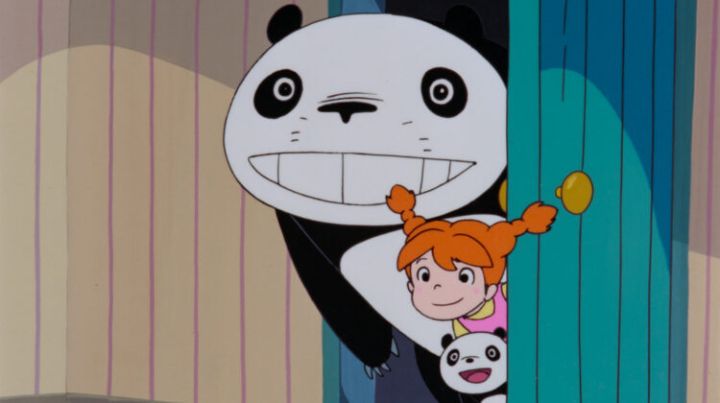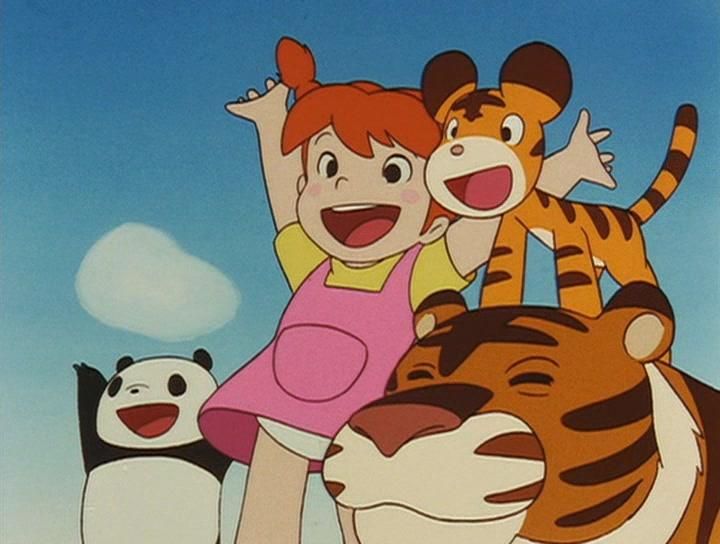






Disclaimer: This is a review of two films, 1972's "Panda! Go, Panda!" (33 minutes) and 1973's "The Rainy-Day Circus" (38 minutes), frequently packaged togehter as one movie. The Japanese title is "Panda Kopanda."Studio Ghibli's films are world-renowned. But as the directors get older, their era has bascially come to an end, After you've seen all of the studio's movies, what else is there to watch? Naturally, you would look at the past films by directors Hayao Miyazaki and Isao Takahata, before they first formed the company. That seems to be the philosophy of GKIDS in North America too: Ghibli is likely their biggest profit maker in home video and theatrical sales, so they've started acquiring documentaries and older films by the directors. Including "Panda! Go, Panda!," a childrens movie from 1972, directed by Takahata and written by Miyazaki, more than a decade before "Nausicaa" was released. The movie wasn't exactly out of print, as Discotek had already printed the movie, among other older films (likely getting a good price on the license at the time). I'm assuming the GKIDS version is identical, save for more consistent packaging with the other Ghibli Blurays. "Panda!" is actually a set of two films, each probably part of a package screening with other movies at the time of release. They star Mimiko, a sweet little girl left alone while her grandmother travels to a funeral for her grandfather. Mimiko (maybe 8 years old at the time) isn't scared to be alone at home. And to her surprise, she finds an unexpected guest: a baby Panda named Panny! And not far behind is Papa Panda, a much larger, but also friendly, talking bear, admiring the bamboo grove outside of Mimiko's house. In the first movie, "Panda! Go, Panda!," they simply run around the house having fun, typically with Mimiko and Panny doing some trick or game, and Papa Panda trying it, before breaking something due to his clumsiness and large weight. In the secomd movie, "The Rainy-Day Circus," they meet a new friend in a baby tiger that ran away from a traveling circus, helping him find his way back to his momma tiger, and helping again when a massive rainstorm floods the circus out.For the most part, these are very much kids movies, made explicitly for children. The plots feel like they've been ripped out of a 8-page picture book. In interviews on the disc, the director talks about the intention to make this something that adults could enjoy too, a successful mantra in later works by Ghibli, Pixar, Laika, and other studios. But it's stretching the idea to apply it to "Panda!"... the movies are sweet and fun, but parents not taken by the cuteness of the characters would probably just use the movies to distract their kids for an hour. There aren't any major themes in the plot, other than the treatment of animals in "The Rainy-Day Circus."  That said, for the child-at-heart, the movies are cute, fun, and inoffensive. The gags and jokes are fun, as are Papa Panda's mannerisms (the English dub is old and not spectacular, but it's funny to hear a Borat-style voice from Papa admiring the "very nice bamboo"). The real surprise in Mimiko herself, who might be inspired by Pippi Longstocking, and other Western tales of resourceful girls like Heidi or Anne of Green Gables (the directors were actively seeking to adapt these stories before working on "Panda!"). Mimiko doesn't seem scared of anything, is always optimistic, and likes to do handstands when she's happy, revealing her bloomers underneath. As fun as the Panda's are, Mimiko could easily carry a children's series on her own. There are some minor cultural oddities that might seem strange to Western adults, however. For example, upon meeting Panny, who has a father but no mother, Mimiko exclaims she can be his mother, while Papa Panda can be her missing papa. It's an innocent way of kids playing "house," but it sounds strange to imagine a small child being a mother, and therefore a wife, to an adult panda, while also being her daughter... maybe best not to think about it. The most interesting thing about the movies to older film fans is their legacy in the careers of Miyazaki and Takahata. Miyazaki wrote the movies, and his touch can be seen in the whimsical nature and strong female lead. Takahata's direction can be seen in the patient portrayal of everyday life and actions, in one of his last children's works (later movies feel intended for adults). There's a clear comparison between "Panda!" and the later movie "My Neighbor Totoro," with the lead animal creatures even having similar designs. The Bluray comes with multiple interviews, each taken many years after "Panda!" was released, but also well before the success of movies like "Spirited Away." Interviews with Takahata are rare, so it's a delight to watch him talk about the movie, as is an even more rare interview of both Takahata and Miyazaki together. As a movie, "Panda! Go, Panda!" is probably the weakest film in the careers of Ghibli's masters, if only due to their simplicity, their age, and low production values (at best, it looks like an old Rankin-Bass movie). To critique it is like trying to review a Dr. Seuss book. There's something charming about that simplicity, and it might be the best "Ghibli" movie to start young children with. It's interesting to watch and recognize where the directors came from, starting with movies like this. But their later movies, when "Ghibli" was properly formed, have more depth and meaning to them, and a lot more to offer.
That said, for the child-at-heart, the movies are cute, fun, and inoffensive. The gags and jokes are fun, as are Papa Panda's mannerisms (the English dub is old and not spectacular, but it's funny to hear a Borat-style voice from Papa admiring the "very nice bamboo"). The real surprise in Mimiko herself, who might be inspired by Pippi Longstocking, and other Western tales of resourceful girls like Heidi or Anne of Green Gables (the directors were actively seeking to adapt these stories before working on "Panda!"). Mimiko doesn't seem scared of anything, is always optimistic, and likes to do handstands when she's happy, revealing her bloomers underneath. As fun as the Panda's are, Mimiko could easily carry a children's series on her own. There are some minor cultural oddities that might seem strange to Western adults, however. For example, upon meeting Panny, who has a father but no mother, Mimiko exclaims she can be his mother, while Papa Panda can be her missing papa. It's an innocent way of kids playing "house," but it sounds strange to imagine a small child being a mother, and therefore a wife, to an adult panda, while also being her daughter... maybe best not to think about it. The most interesting thing about the movies to older film fans is their legacy in the careers of Miyazaki and Takahata. Miyazaki wrote the movies, and his touch can be seen in the whimsical nature and strong female lead. Takahata's direction can be seen in the patient portrayal of everyday life and actions, in one of his last children's works (later movies feel intended for adults). There's a clear comparison between "Panda!" and the later movie "My Neighbor Totoro," with the lead animal creatures even having similar designs. The Bluray comes with multiple interviews, each taken many years after "Panda!" was released, but also well before the success of movies like "Spirited Away." Interviews with Takahata are rare, so it's a delight to watch him talk about the movie, as is an even more rare interview of both Takahata and Miyazaki together. As a movie, "Panda! Go, Panda!" is probably the weakest film in the careers of Ghibli's masters, if only due to their simplicity, their age, and low production values (at best, it looks like an old Rankin-Bass movie). To critique it is like trying to review a Dr. Seuss book. There's something charming about that simplicity, and it might be the best "Ghibli" movie to start young children with. It's interesting to watch and recognize where the directors came from, starting with movies like this. But their later movies, when "Ghibli" was properly formed, have more depth and meaning to them, and a lot more to offer.